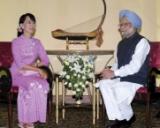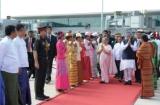DR. SINGH'S MYANMAR VISIT
THE NORTH EAST PRESPECTIVE
 Prime Minister Dr. Manmohan Singh’s recent historic three day visit to Myanmar, the first in a quarter of a century by an Indian Prime Minister is a landmark milestone in the relations between India and Myanmar. With the winds of gradual change blowing in the political landscape of Myanmar, the relations can only but improve and grow stronger to the mutual benefit of both countries. The visit will strengthen and expand bilateral relations which are of a multi-dimensional nature. The visit has also strongly underlined that India will contribute and aid the growth and development of its friend and close neighbour with whom it shares historical, ethnic, cultural and religious ties.
Prime Minister Dr. Manmohan Singh’s recent historic three day visit to Myanmar, the first in a quarter of a century by an Indian Prime Minister is a landmark milestone in the relations between India and Myanmar. With the winds of gradual change blowing in the political landscape of Myanmar, the relations can only but improve and grow stronger to the mutual benefit of both countries. The visit will strengthen and expand bilateral relations which are of a multi-dimensional nature. The visit has also strongly underlined that India will contribute and aid the growth and development of its friend and close neighbour with whom it shares historical, ethnic, cultural and religious ties.
 In the meeting that took place at Myanmar’s new capital city of Nay Pwi Taw on 28th May, Prime Minister Manmohan Singh and President Thein Sein agreed on a vision for the future in the pursuit of the common good - bilaterally, regionally and globally. They agreed to cooperate in areas such as border area development, transportation, connectivity, agriculture, trade and investment, promotion of friendly exchanges and human resource development. They recognized that peace and stability in the region is necessary for development and well-being of the people of their respective countries. In this context, they emphasized the importance of close cooperation between India and Myanmar and the need to effectively harness their respective resources for the good of the people of the two countries.
In the meeting that took place at Myanmar’s new capital city of Nay Pwi Taw on 28th May, Prime Minister Manmohan Singh and President Thein Sein agreed on a vision for the future in the pursuit of the common good - bilaterally, regionally and globally. They agreed to cooperate in areas such as border area development, transportation, connectivity, agriculture, trade and investment, promotion of friendly exchanges and human resource development. They recognized that peace and stability in the region is necessary for development and well-being of the people of their respective countries. In this context, they emphasized the importance of close cooperation between India and Myanmar and the need to effectively harness their respective resources for the good of the people of the two countries.
| Landlocked north east will, within the next few years have access to the sea through the Project which will connect Sittwe in Myanmar to Lawngtlai in the southern part of Mizoram. |
The visit is also very significant for the entire northeastern region of India as Myanmar has an inextricable link with the region. Mizoram, Manipur, Nagaland and Arunachal Pradesh not only share a 1644 km long international boundary with Myanmar but these states also have very close ethnic and cultural ties with the border areas of Myanmar going back deep in history. As the gateway to South East Asia, Myanmar is central to India’s Look East Policy which envisages closer relations with countries in South East and East Asia. Strengthening of bilateral ties can bring new dimensions of growth and development in the landlocked region, improve connectivity and access, boost trade and commerce and promote better people-to-people contacts. Improved Indo-Myanmar relations and the future transition of Myanmar into a fully democratic country will ensure peace and prosperity in this strategic corner of the world. The following paragraphs highlight the issues and areas that are vital for the northeastern region that found space in the discussion between Prime Minister Dr. Manmohan Singh and President U Thein Sein and the various agreements signed between the countries.
| With the winds of gradual change blowing in the political landscape of Myanmar, the relations can only but improve and grow stronger to the mutual benefit of both countries. |
In the meeting, both leaders reaffirmed their shared commitment to fight the scourge of terrorism and insurgent activity in all its forms and manifestations. Both of them emphasized the need for enhanced cooperation between security forces and border guarding agencies for securing peace, security and stability in the border areas, which was crucial for overall development. In this context, the two leaders welcomed the holding of the first meeting of the bilateral Regional Border Committee whose deliberations were useful in promoting such cooperation and understanding for better border management. Both leaders reiterated the assurance that territories of either country would not be allowed to be used for activities inimical to the other, including for training, sanctuary and other operations by terrorist and insurgent organisations and their operatives. Recognizing the importance of sound border management as an intrinsic part of maintaining border security, they directed that the respective Survey Departments should inspect and maintain boundary pillars in a systematic manner. They also directed the respective Heads of Survey Department to finalize dates for an early joint inspection of the sectors jointly identified at the 17th National Level Meeting.

Today the connectivity of the entire northeastern region is through the precariously vital narrow strip of land in North Bengal known as the Siliguri Corridor, often referred to as the chicken neck. It is in some ways the lifeline of the entire north east region, any squeeze on this stretch in the form of bandhs and strikes inevitably brings hardships to the region. The connectivity and dependence will change once the ambitious Kaladan Multi Modal Transit Transport Project is completed. The Project is being developed to provide an alternate route for transport of goods from eastern sea board to north east India. The completion of the Project will open up possibilities for better connectivity and movement of goods between India and Myanmar. Landlocked north east will, within the next few years have access to the sea through the Project which will connect Sittwe in Myanmar to Lawngtlai in the southern part of Mizoram. The Project has the potential to boost the economy of the region as it will provide access to Myanmar’s vast unexplored natural resources. It can also help in the export of resources from the region to countries in South East Asia and further ahead.
| Mizoram, Manipur, Nagaland and Arunachal Pradesh not only share a 1644 km long international boundary with Myanmar but these states also have very close ethnic and cultural ties with the border areas of Myanmar |
During the meeting, the two leaders emphasised the importance of enhancing connectivity between the two countries as a means of promoting commercial, cultural, tourist and other exchanges between the people of the two countries. They expressed satisfaction at the steady progress being made on the Kaladan Multi-Modal Transit Transport Project. They welcomed the finalisation of the site of the Land Customs Station at Zorinpui (Mizoram) following a joint inspection by Indian and Myanmar delegations in April 2012. The project would enhance bilateral trade, people to people contact and contribute to the development and prosperity of the people living in the ‘land locked’ northeastern region of India, they said. The two leaders directed the concerned officials from both sides to finalise all modalities to enable the early operation of the proposed trans-border weekly bus service from Imphal to Mandalay, the second largest city of Myanmar.
 Out of the 12 Memorandum of Understandings (MOUs) that were signed between the two countries during the Prime Minister’s visit the ones that concern the northeastern region in particular are those on India-Myanmar Border Area Development; Establishment of Joint Trade and Investment Forum; Cooperation between Myanmar Institute of Strategic and International Studies and Indian Council of World Affairs; Cooperation between Myanmar Institute of Strategic and International Studies and Institute for Defence Studies and Analysis; Cultural Exchange Programme (2012-2015) and the one on establishing of Border Haats across the border between Myanmar and India.
Out of the 12 Memorandum of Understandings (MOUs) that were signed between the two countries during the Prime Minister’s visit the ones that concern the northeastern region in particular are those on India-Myanmar Border Area Development; Establishment of Joint Trade and Investment Forum; Cooperation between Myanmar Institute of Strategic and International Studies and Indian Council of World Affairs; Cooperation between Myanmar Institute of Strategic and International Studies and Institute for Defence Studies and Analysis; Cultural Exchange Programme (2012-2015) and the one on establishing of Border Haats across the border between Myanmar and India.
The MOU on India-Myanmar Border Area Development will focus on the development and prosperity of the people in bordering areas. Both sides agreed to cooperate to bring about overall socio-economic development in the border areas by undertaking both infrastructure development and micro-economic projects, including upgrade of roads and construction of schools, health centres, bridges, agriculture and related training activities in the area. The President of Myanmar also welcomed India’s offer of assistance in production of large Cardamom in the Naga Self Administered zone. The MOU on establishing of Border Haats across the border between Myanmar and India takes into account the needs of communities residing near the border. The decision to upgrade banking infrastructure at border trade points will also facilitate greater trade between people living in these areas. The two leaders directed that a bilateral Border Trade Committee should be set up to implement the earlier decision that meetings would be held regularly between the border trade officials and businesspersons in Tamu-Moreh and Rhi-Zowkhathar. The Cultural Exchange Programme (CEP) for the period 2012-2015 will promote cultural exchanges between the northeastern states of India and the bordering areas of Myanmar bringing deeper cultural bonding.


